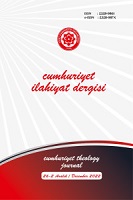Bedreddin Aynî'nin ʿİkdü’l-cümân'ına Göre Memlükler Döneminde Hadis İlmi (VII. Yüzyılın İkinci Yarısı ile VIII. Yüzyılın Başları)
Ḥadīth In The Mamlūk Period According To Badr Al-Dīn al-ʿAynī’s ʿIqd al-jumān (Second Half of The 7th Century – Beginning of The 8th Century)
Author(s): Fatma Betül AltıntaşSubject(s): 6th to 12th Centuries, History of Islam, Sociology of Religion, History of Religion
Published by: Cumhuriyet Üniversitesi İlahyat Fakültesi
Keywords: Ḥadīth; Mamlūks; Badr al-Dīn al-ʿAynī; ʿIqd al-jumān;
Summary/Abstract: History works written in the style of chronicles are used not only for the purpose for which they were written. Chronicles may also contain reflections on the position of the ulema (ʿulamāʾ) at the time of their writing and their worldview regarding the period they lived. This study is based on the book ʿIqd al-jumān fī taʾrīkh ahl al-zamān written by the celebrated Ḥanafī jurist (faqīh) and muḥaddith Badr al-Dīn al-ʿAynī as a public history book. This article focuses on the state of ḥadīth science and scholars during the Mamlūk period between the years 648-707 (1250-1307) and al-ʿAynī’s approaches to these issues based on his ʿIqd al-jumān. For this purpose, the work has been examined in terms of certain keywords that allude to the history of ḥadīth through electronic sources. In addition, the work has been completely reviewed with the traditional method in terms of allusions and information about the ḥadīth studies of the Mamlūks period. Eventually, the elements of ḥadīth scholarship and history, different groups of transmitters, different narration methods, and various works written about ḥadīth have been identified. In addition, the professional, sectarian and political trends of the ḥadith scholars of the period in question were focused on. Chronicles can provide the reader with information of varying layers. In the first layer, biographical information about people such as the dates and places of birth and death of individuals, their students and teachers, the institutions from which they received their education, the cities they traveled to and received knowledge from, the sects they belonged to and their relations with the political figures of the period can be obtained from these books. In the second layer, it is possible to see more extensive data on subjects such as the scholars of the period and scholarly life, based on the particular information obtained from the biographies in the first layer. Information such as important scholarly centers, institutions, teacher-student relations, important muḥaddiths and their sectarian tendencies can be inferred from the first layer. In the third layer, it is possible to get an idea about the perspective of the author on certain issues, based on the data in these two layers. Information that can be relegated to the first layer is plentiful in al-ʿAynī’s work ʿIqd al-jumān. The data in the second and third layers depend on both the presence/density and the interpretation of these materials. For this reason, in this study, revealing the second and third layer information will be possible to the extent that the first layer information allows. ʿIqd al-jumān includes information about the scholarly life of the period in which it was written. al-ʿAynī gives detailed information about the educational institutions, founders of these institutions, their establishment times, and functioning. He also gives details about the foundations, founders and functioning of waqfs, which played a significant role in the operation of the educational institutions. An important aspect that draws attention in ʿIqd al-jumān is that women and their influence on both the establishment and operation of educational institutions and the execution of waqfs are not visible. This is related to the fact that ʿIqd al-jumān is a history book and contains mostly information about a'yān (grandees), and that women are not generally visible among a'yān. Names of people engaged in the science of ḥadīth are also recorded in ʿIqd al-jumān. In this context, the work mentions 170 names interested in the science of ḥadīth. While some of these names only listened to ḥadīth, some of them gave lectures, grant permission to the narrators (al-Ijāzah) and wrote books about ḥadīth. Among these names, there are also those who are interested not only in ḥadīth but also in fiqh or mysticism (taṣawwuf). al-ʿAynī also gives information about the phrases used in ḥadīth narrations. He mentions some methods of narration such as al-samā, al-ijāzah and al-qirā'a in ʿIqd al-jumān. He occasionally provides specific details on who the narrators heard the ḥadīth from. He also emphasizes the names of the narrators who made the last narration (from a certain sheikh), and the narrators who heard a narration alone (tafarrud) from a certain sheikh. If the narrators are the last people who have narrated from well-known names, their status is emphasized. This condition might be understood to mean that having high isnāds is considered beneficial and has an impact on ḥadīth transmission methods. In addition, al-ʿAynī also includes important elements in terms of ḥadīth history, such as ulama families and journeys. In ʿIqd al-jumān, it is possible to see detailed information about the cities where the narrators were born, stayed, visited, settled and died. Cities where the narrators were born, settled and died are significant in that it allows for comments on key centers for ḥadīth and scholars. When the birthplaces of the muḥaddiths are examined, it can be seen that most of the muḥaddiths lived and died in Damascus and Cairo. This study is an example of how to make use of the wafayāt sections in chronicle works. Examining a single book that was not written directly in the field of ḥadīth - even if it contains important information - is not enough to find elements about the history of ḥadīth and to make constructions regarding it. This necessitates the formation of a team that will examine a large number of books using the same criteria.
Journal: Cumhuriyet İlahiyat Dergisi
- Issue Year: 26/2022
- Issue No: 2
- Page Range: 583-603
- Page Count: 21
- Language: Turkish

